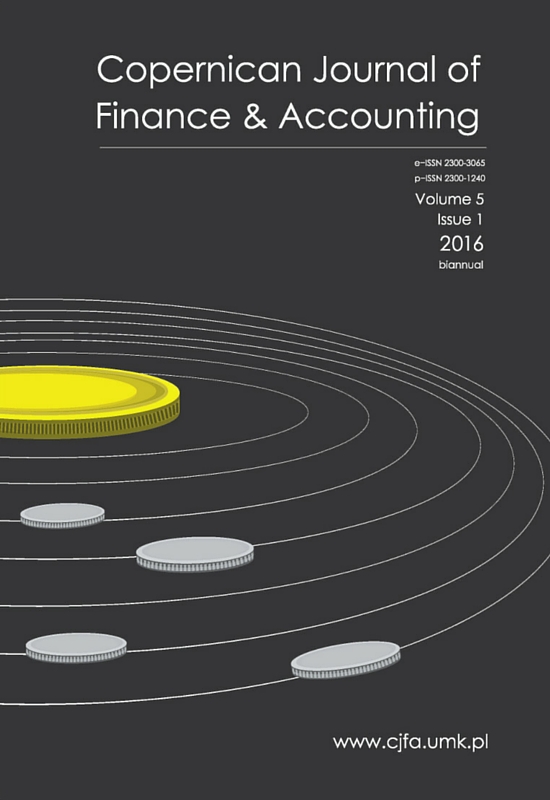Evaluation of relationship between banks lending activities and the economies in Baltic countries
DOI:
https://doi.org/10.12775/CJFA.2016.008Słowa kluczowe
banks, credit, households, lending activities, non-financial corporations, Granger causalityAbstrakt
Banks are financial institutions that are part of each country financial system. One of the banks’ core businesses is lending activity, which includes the lending activity to households, non-financial corporations and other financial institutions. Before the financial crisis until 2007 year in all the Baltic countries amounts of loans have a tendency to increase and its impact to economy become even more important. The analysis of scientific literature showed that there are different opinions concerning the relationship between banks’ lending activities (credits) and the economies. Some researchers argue that lending activities have a positive impact on country economic growth, others state that its impact is opposite – economies have a positive impact on lending activities, while the others claim that there is no relationship between mentioned variables. The performed research showed that there are strong and medium strengths positive linear relationships between lending activities and GDP in all the Baltic countries. Granger causality test showed that with one period lag, GDP affects household loans variations in Latvia and with two periods of lags, GDP has an impact on the volume of loans to non-financial corporations. While in Lithuania and Estonia the relationship, assessing one and two number of lags, between lending activities and economies was not found.
Bibliografia
Bank of Estonia (2015). Bank of Estonia Statistics. http://statistika.eestipank. ee/?lng=en#listMenu/1172/treeMenu/FINANTSSEKTOR/147/650 (accessed: 02.05. 2015).
Bank of Latvia (2015). Bank of Latvia statistics archive, https://www.bank.lv/en/statistics/ monetary-statistics/mfi-balance-sheet-and-monetary-statistics/7333-tmp (accessed: 02.05.2015).
Bank of Lithuania (2014). Bank of Lithuania statistics. http://www.lb.lt/stat_pub/statbrowser. aspx?group=7279 (accessed: 02.05.2015).
Boguslauskas, V., Bliekiene, R., Grondskis, G., & Maksvytis, L. (2009). Econometrics. Regression models, Kaunas: Technologija.
Cetin, H. (2016). The Relationship between Turkey’s Financial Indicators and Economic Growth Rates. Journal of Economics, Business and Management, vol. 4, no. 1, pp. 36- 39.
Eurostat (2015). Eurostat database. http://ec.europa.eu/eurostat/data/database, (accessed: 29.04.2015).
Gozgor, G. (2015). Causal relation between economic growth and domestic credit in the economic globalization: Evidence from the Hatemi-J’s test. The Journal of International Trade & Economic Development, vol. 24, no. 3, pp. 395-408.
Iqbal, M.Z., Ahmad, N., & Hussain, Z. (2012). Impact of Savings and Credit on Economic Growth in Pakistan, Pakistan Journal of Social Sciences (PJSS), vol. 32, no. 1, pp. 39- 48.
Jasiene, M., & Capskas, G. (2008). Investigation of Dynamics and its Factors of Interest Rates in Lithuania in 1994-2006, Business: Theory and Practise, 9(1), pp. 33-44.
Koivu, T. (2002). Do efficient banking sectors accelerate economic growth in transition countries?, BOFIT Discussion Papers, Bank of Finland, Institute for Economies in Transition, no. 14, pp. 1-24.
Korkmaz, S. (2015). Impact of Bank Credits on Economic Growth and Inflation. Journal of Applied Finance & Banking, vol. 5, no. 1, pp. 57-69.
Krishnankutty, R. (2011). Role of Banks Credit in Economic Growth: a Study with Special Reference to North East India. The Economic Research Guardian, vol. 1(2), pp. 60-71.
Lakstutiene A., Krusinskas, R., & Platenkoviene, J. (2011). Economic Cycle and Credit Volume Interaction: Case of Lithuania, Engineering Economics, no. 22(5), pp. 468-476.
Leitão, N.C. (2012). Bank Credit and Economic Growth: a Dynamic Panel Data Analysis, The Economic Researrch Guarrdian, vol. 2(2), pp. 256-267.
Mamman, A., & Hashim, Y.A. (2014). Impact of Bank Lending on Economic Growth in Nigeria. Research Journal of Finance and Accounting, vol. 5, no. 18, pp. 174-182.
Methodological Notes (2014). definitions of non-financial corporations and households, https://www.lb.lt/notes (accessed: 22.04.2015).
Murty, K.S., Sailaja, K., & Demissie, W.M. (2012). The Long-Run Impact of Bank Credit on Economic Growth in Ethiopia: Evidence from the Johansen’s Multivariate Cointegration Approach, European Journal of Business and Management, vol. 4, no. 14, pp. 20- 33.
Oluitan, R.O. (2012). Bank Credit and Economic Growth: Evidence from Nigeria. International Business and Management, vol. 5, no. 2, pp. 102-110.
Onuorah, A. Chi-Chi & Ozurumba, B.A. (2013). Bank Credits: An Aid to Economic Growth In Nigeria, Information and Knowledge Management, vol.3, no.3, pp. 41-50.
Ramanauskas, T. (2005). Assessment of Bank Credit Growth from Macroeconomic Perspective, Pinigų studijos 2005/3, pp. 78-97.
Takáts, E., & Upper, C. (2013). Credit and growth after financial crises, BIS Working Papers, Bank for International Settlements, Monetary and Economic Department, no. 416, pp. 1-24.
Ugoani, J.N.N. (2013). Power of Bank Credit on Economic Growth: A Nigerian Perspective. International Journal of Financial Economics, vol. 1, no. 3, pp. 93-102.
Were, M., Nzomoi, J., & Rutto, N. (2012). Assessing the Impact of Private Sector Credit on Economic Performance: Evidence from Sectoral Panel Data for Kenya. International Journal of Economics and Finance, vol. 4, no. 3, pp. 182-190.
Yakubu, Z., & Affoi, A.Y. (2014). An Analysis of Commercial Banks’ Credit on Economic Growth in Nigeria. Current Research Journal of Economic Theory, no. 6(2), pp. 11-15.
Pobrania
Opublikowane
Jak cytować
Numer
Dział
Statystyki
Liczba wyświetleń i pobrań: 761
Liczba cytowań: 0



